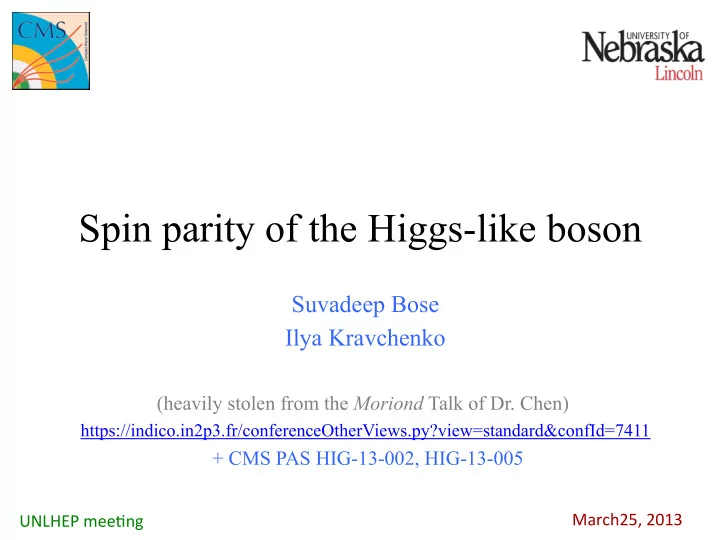

Spin parity of the Higgs-like boson Suvadeep Bose Ilya Kravchenko (heavily stolen from the Moriond Talk of Dr. Chen) https://indico.in2p3.fr/conferenceOtherViews.py?view=standard&confId=7411 + CMS PAS HIG-13-002, HIG-13-005 March25, ¡2013 ¡ UNLHEP ¡mee*ng ¡
Signal strengths CMS ¡ § Given ¡the ¡mass, ¡proper*es ¡of ¡the ¡SM ¡ ¡ Higgs ¡boson ¡are ¡all ¡known ¡theore*cally ¡ § Proceed ¡to ¡test ¡data ¡whether ¡it ¡is ¡ compa*ble ¡with ¡SM ¡predic*on ¡on ¡ ¡ ¡ ¡ ¡ ¡ ¡various ¡proper*es ¡ -‑ signal ¡strengths ¡ -‑ spin ¡parity ¡ -‑ couplings ¡ § Overall ¡signal ¡strength ¡(common ¡scale ¡ factor ¡for ¡expected ¡signal ¡event ¡yields ¡in ¡ all ¡channels): ¡μ ¡= ¡0.88 ¡+ ¡0.21 ¡ § Sub-‑combina*ons ¡grouped ¡by ¡ ¡ (production tag) x (decay mode) � χ 2 /ndf ¡= ¡8.7/11 ¡ P(χ 2 >8.7|ndf=11)=0.65 ¡ Results ¡are ¡consistent ¡with ¡the ¡SM ¡Higgs ¡boson ¡ 2 ¡ Suvadeep ¡Bose ¡
Introduction § What ¡can ¡the ¡spin ¡of ¡the ¡“new ¡found” ¡par*cle ¡be? ¡ Ø That’s ¡why ¡it ¡is ¡very ¡important ¡to ¡observe ¡Higgs ¡in ¡ττ ¡channel ¡– ¡which ¡will ¡ ¡ rule ¡out ¡for ¡it ¡to ¡have ¡a ¡spin ¡of ¡2 ¡ ¡ 3 ¡ Suvadeep ¡Bose ¡
Spin Parity q So ¡far ¡we ¡know ¡the ¡observed ¡par*cle ¡(assuming ¡just ¡one ¡par*cle) ¡ § X ¡is ¡a ¡boson ¡(decays ¡to ¡γγ, ¡4l ¡etc) ¡ § X ¡can ¡not ¡be ¡spin ¡1 ¡(decays ¡to ¡γγ ¡+ ¡Landau-‑Yang ¡theorem) ¡ § X ¡can ¡not ¡be ¡100% ¡0 -‑ ¡(from ¡4l ¡correla*ons) ¡PRL ¡ 110 , ¡081803 ¡(2013) ¡ ¡ ¡ q Further ¡tests ¡in ¡4l ¡and ¡WW(lνlν) ¡channels ¡with ¡full ¡data ¡on ¡a ¡few ¡reasonably ¡well ¡ ¡ mo*vated ¡J P ¡hypothesis ¡(“pure” ¡states ¡only) ¡w.r.t. ¡SM ¡Higgs ¡boson ¡ NB: ¡tes*ng ¡spin-‑1 ¡hypothesis ¡makes ¡sense ¡if ¡the ¡excesses ¡come ¡from ¡more ¡than ¡one ¡par*cle ¡ 4 ¡ Suvadeep ¡Bose ¡
Matrix Element approach in 4l § Build ¡two ¡discriminant ¡based ¡on ¡the ¡complete ¡Leading-‑Order ¡MEs ¡ § D bkg ¡to ¡separate ¡signal ¡from ¡ background ¡(ME ¡combined ¡with ¡ pdf(m 4l ) ¡ § D JP ¡to ¡separate ¡the ¡SM ¡Higgs ¡ boson ¡from ¡alterna*ve ¡J P ¡ hypothesis ¡ ¡ § Exploit ¡fully ¡the ¡(D bkg , ¡D JP ) ¡– ¡plane ¡in ¡ sta*s*cal ¡analysis ¡ 5 ¡ Suvadeep ¡Bose ¡
DJP distributions (with D bkg >0.5) 6 ¡ Suvadeep ¡Bose ¡
Spin-parity : test statistics 7 ¡ Suvadeep ¡Bose ¡
Spin-parity: results ¡ § The ¡studied ¡pseudo-‑scalar, ¡spin-‑1 ¡and ¡spin-‑2 ¡models ¡are ¡ ¡ ¡ ¡ ¡ ¡excluded ¡at ¡95% ¡CL ¡or ¡higher ¡ 8 ¡ Suvadeep ¡Bose ¡
D JP distributions (with D bkg >0.5) § Expected ¡separa*on ¡is ¡at ¡the ¡ 2-‑σ ¡level ¡ Data ¡is ¡consistent ¡with ¡both ¡ § hypothesis ¡and ¡slightly ¡ favoring ¡0 + ¡ 9 ¡ Suvadeep ¡Bose ¡
Coupling compatibility tests § 8 ¡independent ¡parameters ¡(Γ ZZ , ¡Γ WW , ¡Γ ττ , ¡Γ bb , ¡Γ γγ , ¡Γ gg , ¡Γ r ¡and ¡Γ TOT ) ¡to ¡ ¡ describe ¡all ¡currently ¡relevant ¡decays ¡and ¡produc*on ¡mechanisms ¡ ¡ ¡ N(xx->H->yy) ~ σ (xx->H).B(H->yy) ~ ( Γ xx Γ yy / Γ tot ) ¡ § Extrac*on ¡of ¡all ¡8 ¡parameters ¡is ¡too ¡early ¡with ¡the ¡current ¡data ¡ ¡ § Instead, ¡we ¡go ¡ater ¡couplings ¡compa*bility ¡tests ¡ ¡-‑ ¡ ¡assume ¡SM ¡Higgs ¡couplings ¡ ¡-‑ ¡ ¡introduce ¡a ¡limited ¡number ¡of ¡scaling ¡factors ¡(κ, ¡λ) ¡ ¡ ¡ ¡ ¡ ¡ ¡ ¡ ¡ ¡ ¡ ¡for ¡couplings ¡and ¡ra*o ¡of ¡couplings ¡ ¡ ¡ 10 ¡ Suvadeep ¡Bose ¡
κ V and κ F Data ¡consistent ¡with ¡(κ V ;κ F )=(1;1) ¡ § A ¡map ¡vectorial ¡and ¡fermionic ¡couplings ¡into ¡2 ¡scale ¡factors, ¡κ V ¡and ¡κ F ¡ ¡ ¡H-‑>(W ¡and ¡t ¡loops)-‑>γγ ¡ 11 ¡ Suvadeep ¡Bose ¡
Conclusions § Data ¡is ¡consistent ¡with ¡SM ¡0 + ¡and ¡disfavoring ¡following ¡pure ¡states: ¡ Ø ¡ pseudo ¡–scalar ¡ Ø ¡ vector ¡and ¡pseudo-‑vector ¡ Ø ¡ spin ¡2 ¡resonances ¡with ¡minimal ¡couplings ¡ ¡ “Higgs-‑like” ¡-‑> ¡“Higgs” ¡ 12 ¡ Suvadeep ¡Bose ¡
Back up 13 ¡ Suvadeep ¡Bose ¡
How the CL s Exclusion Limit is obtained § The ¡distribu*on ¡of ¡ ¡ ¡ ¡ ¡ ¡ ¡ ¡ ¡ ¡ ¡ ¡ ¡ ¡ ¡ ¡ ¡ ¡ ¡ ¡ ¡ ¡ ¡ ¡ ¡ ¡ ¡ ¡ ¡ ¡ ¡ ¡ ¡ ¡ ¡ ¡ ¡ ¡is ¡examined ¡with ¡ ¡ generated ¡samples ¡of ¡background ¡and ¡signal ¡of ¡7 ¡types ¡ ¡ (SM ¡ 0 + ¡ and ¡6 ¡ J P ) ¡for ¡m H ¡= ¡126 ¡GeV ¡ § Likelihoods ¡ L ¡are ¡calculated ¡with ¡the ¡signal ¡rates ¡ ¡ allowed ¡to ¡float ¡independently ¡for ¡each ¡signal ¡type ¡and ¡the ¡ nuisance ¡parameters ¡are ¡treated ¡as ¡independent. ¡ ¡ § Adjust ¡the ¡rela*ve ¡expected ¡yield ¡distribu*ons ¡ in ¡the ¡different ¡channels ¡in ¡alterna*ve ¡J P ¡hypotheses ¡which ¡differ ¡ ¡ from ¡SM ¡due ¡to ¡kinema*cs ¡and ¡detector ¡effects. ¡ ¡ § Expected ¡distribu*ons ¡are ¡generated ¡with ¡the ¡cross ¡sec*on ¡ for ¡each ¡type ¡of ¡signal ¡determined ¡from ¡the ¡fit ¡to ¡data. ¡ ¡ § Consistent ¡results ¡ ¡when ¡the ¡expected ¡distribu*ons ¡are ¡generated ¡ ¡ with ¡the ¡signal ¡event ¡yields ¡according ¡to ¡SM ¡expecta*on. ¡ 14 ¡ Suvadeep ¡Bose ¡
Recommend
More recommend